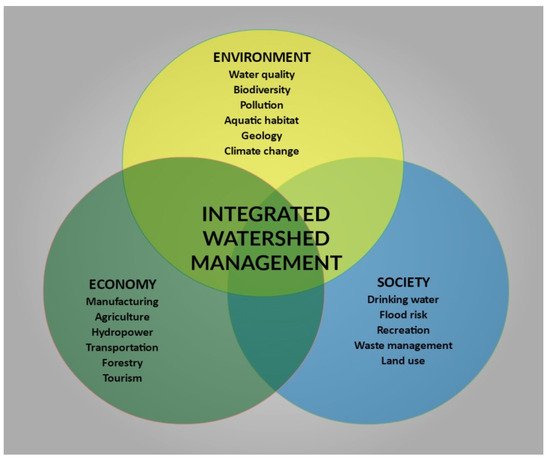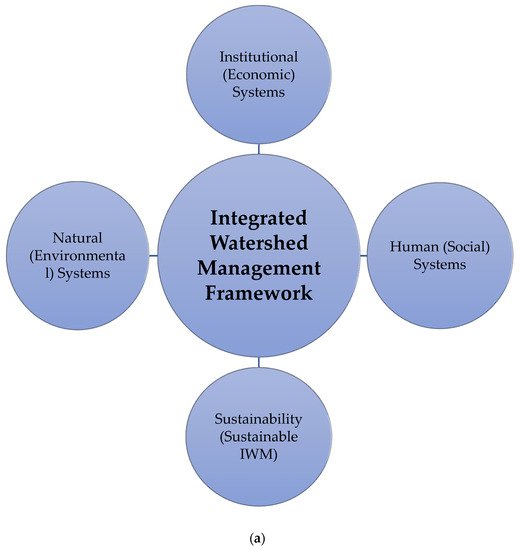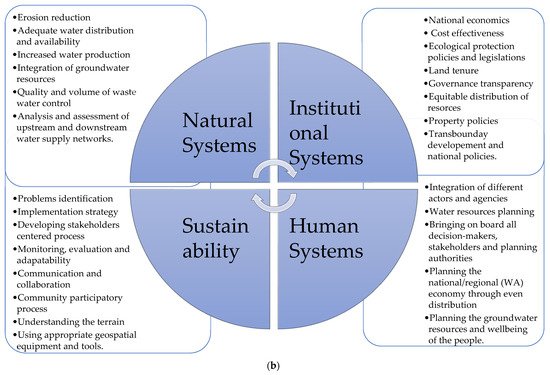You're using an outdated browser. Please upgrade to a modern browser for the best experience.
Please note this is a comparison between Version 2 by Rita Xu and Version 1 by John Adekunle Adesina.
Human activities mostly impact the trend and direction of rainwater, groundwater, and other river basin resources in the watershed in Africa. These activities alter river flows and the quality of usable water supplies at both highlands and lowlands. A watershed is indeed a conserved area of land that collects rain, sleet and snow, and empties or penetrates groundwater sources.
- Africa
- biodiversity
- groundwater resources
- integrated watershed management
1. Introduction
A watershed is a biophysically defined region delimited by the direction of the water network and drained by a tide or series of streams to a single outlet point or catchment area [1,2][1][2]. A “land area that drains into a stream” is referred to as a watershed [2]. “The use, management, and investment in multiple interrelated resources within watersheds” is what watershed management entails. It refers to the sustainable management and protection of all the ecological resources in a watershed, the natural forests and other land uses, as well as groundwater, which is not left out. Watersheds are distinct locations that are generally defined by a diversity of ecological, political and socioeconomic characteristics [1]. The interests of stakeholders, who might differ across upstream and downstream consumers as well as between sectors of the economy, are, nevertheless, extremely complicated. “Watersheds are usually large, and several people, communities, companies and groups are willing to participate in how they are managed” [3]. Water, soil, nutrients, and pollutants move across various areas of a watershed, forming physical links and landscape network connectivity between individuals who are geographically apart [3]. Watersheds are brimming with production and consumption externalities in economic terms. It has long been understood that water resources are inextricably linked to the ecosystem and people who live in it [3]. The increased focus on watershed management can also be seen in the large amount of money invested in watershed projects in recent years all around the world, but especially in Africa and Asia [3,4][3][4]. Even though the focus of this review paper is on integrated watershed management and other natural groundwater resources in the watershed, river basins and catchment areas are taken into account.
2. Watershed Management in Africa
A drainage basin is a land area where water flows and drains into a widespread water body, including a stream, lagoon, lake, or coast [4]. A watershed is a natural system that includes water, plants, animals, marshes, moraines, and forests that interact [5]. When water flows out of the watershed, the watershed boundary will approximately track the steepest slope around the stream channels, finally meeting at the bottom or lower part of the land, the canal mouth. The majority of the water comes from rain and stormwater runoff. Within a watershed, all changes to the land, such as extraction, farmland, roads, urban development, and human anthropogenic factors, affect the quality and quantity of stormwater [4,5][4][5]. Watersheds are separated from one another by naturally elevated areas [5].
Why Are Watershed and Groundwater Resources Important?
Surface water features and stormwater runoff within a watershed eventually flow to other bodies of water, making watersheds significant. When executing water quality protection, sustenance, and restoration initiatives, it is critical to consider these downstream effects [5]. Everything that happens upstream eventually ends up downstream. We must keep in mind that we all live downstream and that our daily actions might have an impact on downstream rivers. Environmental management has traditionally been focused on individual concerns, such as air, land, and water [6]. The majority of these efforts have resulted in lower pollutant emissions to the air and water; improved landfills, waste sites, and contaminated groundwater remediation; protection of rare and endangered species; development of best management practices to control water and contaminant runoff; and much more. Nonpoint source pollution and habitat loss continue to be a challenge for our river basins and seas. These are the issues that are causing the majority of the water quality issues across the board. They are often difficult to manage encumbered by complicated challenges. Nonpoint pollution and habitat degradation are often considered to be cross-program regional issues [7].
The primary goal of the erosion and watershed management initiatives is to reduce soil erosion susceptibility in designated sub-watersheds across Africa, particularly in West Africa. The capital investments in erosion and watershed management component will support on-the-ground interventions to help reduce vulnerability to land degradation; erosion and watershed management institutions and information services will strengthen the enabling environment for effective erosion and watershed management implementation. These approaches will improve the capacities, modernization, and coordination of relevant federal, state, and local institutions involved in investment preparation, governance, evaluation, regulation, and surveillance of watershed and erosion-related activities, as well as flood risk management; the adaptation and mitigation elements will include climate actions that help strengthen Africa’s theoretical foundation for dealing with climate change and all its environmental and ecological impacts [8].
Watershed management’s ultimate goal is to maintain balanced social, economic, and ecological watershed functions, therefore contributing to long-term development and the decrease in negative external consequences in an area of action [8]. This assumes that at the regional level, proper policies, regulations, and institutions are in place and respected. The goal establishes a framework for achieving the following major watershed management objectives: ensuring that beneficial uses of water resources and other related resources are maintained, achieving specified and agreed-upon management targets for water and related resources, avoiding negative off-site impacts (externalities) on water and related resources, and recognizing and avoiding negative human impacts on watershed functions. It also helps to promote social and economic growth, to protect, reduce, or repair natural resources and the environment, reduce local susceptibility to climate extremes, and maintain a balanced biodiversity action [9].
The aforementioned watershed management goals are dependent on country-specific circumstances, as well as the priorities of higher-ranking development programs and plans. These vary significantly between nations and sub-regions at large, however as one country-specific example action [10]. To attain these goals, a variety of activities and methods are possible, including but not limited to drafting and passing relevant policies and legislation, as well as establishing supporting institutions. Reducing riverbank erosion, minimizing sediment transit and buildup, and increasing water quality, biodiversity preservation, aquatic habitat control and climate change mitigation/adaptation are all benefits of managing the river flow regime as illustrated in Figure 1 [11]. This helps to maintain good water quality and supply standards that comply with government regulations and community expectations. Flooding, erosion, weathering, droughts, and landslides are all-natural calamities that may be avoided [6].


Figure 1. Policy priorities of Integrated Watershed Management. Source: https://conservationontario.ca/Conservation Ontario (2012) (accessed on 1 December 2021) [11].
Integrated watershed management effectively uses natural resources to reduce negative impacts and consequences, avoid environmental degradation, boost water output, and increase biomass production. Promoting suitable agriculture and forestry land-use practices, as well as accompanying soil and water conservation measures that allow for adequate production levels, while minimizing long-term negative consequences on the watershed’s natural resources. This promotes economic and human exploration and production through job and income-generating activities. Encourage the use of the development of indigenous technical knowledge and materials through simple, accessible, and economical technology solutions and institutional structures. The economic and social circumstances of the poor and those with limited resources are drastically improved while also helping in increasing the distribution of the benefits of land and water resources development across all the environmental stakeholders. Most of these actions and measures have been planned and implemented in the past under the umbrella of watershed management in some form or another [6,7,8,9][6][7][8][9]. This might explain why there are so many different perspectives and definitions of watershed management [6]. The proposed IWM conceptual framework in this study (Figure 2a,b), according to various literature, gives a detailed illustration of the key drivers of IWM and the strategic continental, sub-regional and national management measures.




Figure 2. (a) Integrated Watershed Management key drivers, (b) IWM conceptual framework illustrating the natural, institutional, human, and sustainability strategies as part of watershed management measures.
Watershed management has acquired prominence and relevance in both environmental preservation and the wellbeing of the people living in watershed regions during the previous past decades (see Figure 2b). The Bhutan government, a country of south-central Asia, located on the eastern ridges of the Himalayas as well as the Nigerian government in West Africa, for example, identified IWM as the “major and critical approach to preserve the resource base to support the national economy” in its policy statements [11].
The idea behind watershed management initiatives is that some groundwater resources are better-controlled on a river basin scale. Multiple scales and a combination of physical and social variables are prevalent, necessitating an interdisciplinary approach [11]. Due to a variety of physical and social properties, rivers and streams are seen to be useful ecological components and action units for every natural habitat [12]. Table 1 clearly explain the biophysical and environmental (socio-cultural) factors that characterized the management, sustainable usability and functions of watersheds in Africa.
Table 1.
Showing the physical and environmental characteristics of watersheds/catchments and river basins in Africa.
| Physical & Environmental Factors | Characteristics |
|---|---|
| Biophysical System | Natural biophysical units such as watersheds/catchments and river basins are useful for monitoring natural processes. |
| Multiple Scales | Watersheds/catchments and river basins establish distinct nested landscape hierarchies that emphasize biophysical interdependence at large numbers. |
| Process Investigations | Large scale, input-output, and irrigation analyses, as well as cause-and-effect interactions, may all be analyzed using watersheds and river basins. |
| Integrated Framework | Watersheds take into account all land-use consequences and emphasize the connections between land use and other natural systems. |
| Assist in Addressing Complexity | Its cumulative impacts can be studied, and interactions between the atmosphere, soil, and water can be determined. |
| Socio-cultural Factors | |
| Tool for Making Scientific Decisions | Watersheds make scientific judgements easier since they are geological divisions. These serve as a stable platform for complex and adaptable governance. |
| Links Across Borders | Watersheds are defined by watercourses, which comprise interconnected natural resources. This unites countries and regions by inland flow and continuing occurrence across stream borders. |
| Social Organization | As a result of their social construction, watersheds may serve as a communal gathering spot for dialogue, settlement, management, and observation. |
According to the World Bank report [13], over 65% of Africa’s population lives in rural areas, with many of them on modest subsistence farms. Rockström and Falkenmark [14] also shared the same opinion about the population of Africa. Rain-fed agriculture accounts for 95% of cropland in sub-Saharan Africa, leaving most people highly reliant on the annual rainfall pattern. Rainfall that is timely and enough is critical for small agricultural communities’ livelihoods and food security [15]. The impact of adequate groundwater supply is important in certain countries, such as the West Africa sub-region, where agriculture employs more than 80% of the people [15,16][15][16].
The importance of timely rainfall to the whole economy cannot be overstated. However, rainfall in Africa varies dramatically on an annual, decadal, and longer time scale [17]. Senegal, Mali, Burkina Faso, Niger, Nigeria, Chad, Sudan, Ethiopia, Somalia, Kenya, Tanzania, Zambia, Malawi, Mozambique, Zimbabwe, and South Africa account for the majority of Africa’s 100 million people living in water-stressed rain-fed agriculture [18,19,20][18][19][20].
References
- Patle, D.; Rao, J.H.; Dubey, S. Morphometric analysis and prioritization of sub-watersheds in Nahra watershed of Balaghat district, Madhya Pradesh: A remote sensing and GIS perspective. J. Exp. Biol. Agric. Sci. 2020, 8, 447–455.
- Glossary of Terms for Negotiators of Multilateral Environmental Agreements, Division of Environmental Law and Conventions, United Nations Environment Programme, UNEP/Earth Print. 2007. Available online: https://www.unep.org/resources/report/glossary-terms-negotiators-multilateral-environmental-agreements (accessed on 1 December 2021).
- Heathcote, I.W. Integrated Watershed Management: Principles and Practice; John Wiley & Sons: Hoboken, NJ, USA, 2009; ISBN 978-0-470-37625-6. Available online: https://www.osti.gov/biblio/298224-integrated-watershed-management-principles-practice (accessed on 1 December 2021).
- Pavelic, P.; Brindha, K.; Amarnath, G.; Eriyagama, N.; Muthuwatta, L.; Smakhtin, V.; Kant, L. Controlling Floods and Droughts through Underground Storage: From Concept to Pilot Implementation in the Ganges River Basin; International Water Management Institute (IWMI): Gujarat, India, 2015; Volume 165, Available online: https://www.dadoslivres.com/telecharger/controlling-floods-and-droughts-through-underground-storage-from-concept-to-pilot-implementation-in-the-ganges-river-basin/ (accessed on 1 December 2021).
- Verry, E.S.; Hornbeck, J.W.; Dolloff, C.A. Riparian Management in Forests of the Continental Eastern United States; Lewis Publishers: Boca Raton, FL, USA, 1999; pp. 125–138. Available online: https://www.fs.usda.gov/treesearch/pubs/9428 (accessed on 1 December 2021).
- Sharma, N.; Zakaullah, M.; Tiwari, H.; Kumar, D. Runoff and sediment yield modelling using ANN and support vector machines: A case study from Nepal watershed. Model. Earth Syst. Environ. 2015, 1, 23.
- Sharma, T. Watershed Management and policies in India. Int. J. Res.-Granthaalayah 2015, 3, 1–4.
- Willems, P.; Olsson, J.; Arnbjerg-Nielsen, K.; Beecham, S.; Pathirana, A.; Bülow Gregersen, I.; Eng, S.J.A.P. African Development Bank’s Experience Following Nexus Approach–Case Studies in Integrated Watershed Management to achieve Food Security and Sustainable Natural Resources Management from the Republic of Cape Verde, Burundi, and the Gambia. In Proceedings of the International Kick-Off Workshop, 11–12 November 2013; Technical University Dresden: Dresden, Germany, 2013; pp. 121–143. Available online: https://collections.unu.edu/eserv/UNU:2692/Proceedings_KickOffWorkshopNexusApproach.pdf (accessed on 1 December 2021).
- Medema, W.; McIntosh, B.S.; Jeffrey, P.J. From premise to practise: A critical assessment of integrated water resources management and adaptive management approaches in the water sector. Ecol. Soc. 2008, 13, 29.
- Ravindranath, N.H.; Sathaye, J.A. Climate Change and Developing Countries. In Climate Change and Developing Countries; Springer: Dordrecht, The Netherlands, 2002; pp. 247–265. Available online: https://www.coursehero.com/tutors-problems/Business-Other/34242542-Hi-can-you-give-me-9-scholarly-articles-to-read-so-I-can-answer// (accessed on 1 December 2021).
- Conservation Ontario. Overview of Integrated Watershed Management in Ontario; Conservation Ontario: Newmarket, ON, Canada, 2010.
- Jamtsho, K.; Gyamtsho, T. Effective Watershed and Water Management at the Local Level: Challenges and Opportunities; International Development and Research Council: Ottawa, ON, Canada, 2003; Available online: https://idl-bnc-idrc.dspacedirect.org/handle/10625/29436 (accessed on 1 December 2021).
- Bureau, R. Watershed management research: A review of IDRC projects in Asia and Latin America. In Rural Poverty and Environment Working Paper Series; International Development and Research Council: Ottawa, ON, Canada, 2005; no. 18; Available online: https://idl-bnc-idrc.dspacedirect.org/handle/10625/25832 (accessed on 1 December 2021).
- World Bank. World Development Report 2008: Agriculture for Development, the World Bank. 2007. Available online: www.elibrary.worldbank.org (accessed on 1 December 2021).
- Rockström, J.; Falkenmark, M. Agriculture: Increase water harvesting in Africa. Nature 2015, 519, 283–285.
- Akudugu, M.A.; Dittoh, S.; Mahama, E.S. The implications of climate change on food security and rural livelihoods: Experiences from Northern Ghana. J. Environ. Earth Sci. 2012, 2, 21–29.
- Namara, R.E.; Horowitz, L.; Nyamadi, B.; Barry, B. Irrigation Development in Ghana: Past Experiences, Emerging Opportunities, and Future Directions. 2011. Available online: https://reliefweb.int/sites/reliefweb.int/files/resources/Full_Report_228.pdf (accessed on 1 December 2021).
- Seddon, D.; Kashaigili, J.J.; Taylor, R.G.; Cuthbert, M.O.; Mwihumbo, C.; MacDonald, A.M. Focused groundwater recharge in tropical dryland: Empirical evidence from central, semi-arid Tanzania. J. Hydrol. Reg. Stud. 2021, 37, 100919.
- Rockström, J.; Falkenmark, M.; Karlberg, L.; Hoff, H.; Rost, S.; Gerten, D. Future water availability for global food production: The potential of green water for increasing resilience to global change. Water Resour. Res. 2009, 45, 2–16.
- Aduah, M.S.; Jewitt, G.P.W.; Toucher, M.L.W. Assessing Impacts of Land Use Changes on the Hydrology of a Lowland Rainforest Catchment in Ghana, West Africa. Water 2018, 10, 9.
More
